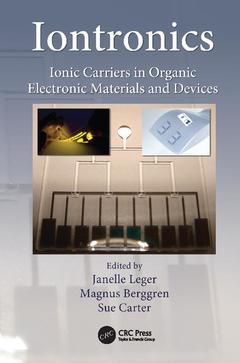Iontronics Ionic Carriers in Organic Electronic Materials and Devices
Coordonnateurs : Leger Janelle, Berggren Magnus, Carter Sue

The field of organic electronics promises exciting new technologies based on inexpensive and mechanically flexible electronic devices, and is now seeing the beginning of commercial success. On the sidelines of this increasingly well-established field are several emerging technologies with innovative mechanisms and functions that utilize the mixed ionic/electronic conducting character of conjugated organic materials. Iontronics: Ionic Carriers in Organic Electronic Materials and Devices explores the potential of these materials, which can endow electronic devices with unique functionalities.
Fundamental science and applications
With contributions from a community of experts, the book focuses on the use of ionic functions to define the principle of operation in polymer devices. It begins by reviewing the scientific understanding and important scientific discoveries in the electrochemistry of conjugated polymers. It examines the known effects of ion incorporation, including the theory and modulation of electrochemistry in polymer films, and it explores the coupling of electronic and ionic transport in polymer films. The authors also describe applications that use this technology, including polymer electrochromic devices, artificial muscles, light-emitting electrochemical cells, and biosensors, and they discuss the fundamental technological hurdles in these areas.
The changes in materials properties and device characteristics due to ionic conductivity and electrochemical doping in electrically conductive organic materials, as well as the importance of these processes in a number of different and exciting technologies, point to a large untapped potential in the development of new applications and novel device architecture. This volume captures the state of the science in this burgeoning field.
Electrochemistry of Conjugated Polymers. From Metal to Semiconductor and Back—Thirty Years of Conjugated Polymer Electrochemistry. Development and Applications of Ion-Functionalized Conjugated Polymers. Electrochemical Biosensors Based on Conducting Polymers. The Light-Emitting Electrochemical Cell. Fixed Junction Light-Emitting Electrochemical Cells. Electrochromic Displays. Conjugated Polymers as Actuators for Medical Devices and Microsystems. Organic Electrochemical Transistors for Sensor Applications. Polyelectrolyte-Gated Organic Field-Effect Transistors.
Janelle Leger is an Assistant Professor at Western Washington University in the Department of Physics and Astronomy, the Department of Chemistry, and the Advanced Materials Science and Engineering Center. Her research group explores organic and hybrid electronic and optoelectronic devices as well as structures for subwavelength optics.
Magnus Berggren is the Önnesjö professor at Linköping University, Sweden, and guides the research activity of the organic electronics group. This group explores electronic and optoelectronic functions of organic materials for paper electronics and bioelectronics applications.
Sue A. Carter is a Professor of Physics at University of California, Santa Cruz. Over the last 15 years, her research has focused on the electronic, magnetic, thermal, and optical properties of inorganic, organic, and biological materials. Currently, she is studying the application of nanostructured materials to next generation energy technologies, including solid-state lighting, solar cells, and electrochemical cells.
Date de parution : 06-2017
15.6x23.4 cm
Date de parution : 10-2010
15.6x23.4 cm
Thèmes d’Iontronics :
Mots-clés :
PPy Film; CPs; conjugate; LEC; polymer; Electrochemical Doping; organic; Potential Drop; semiconductor; Voltage; electrochemical; Organic Field; Effect Transistors; doping; PPy; polythiophene; Organic Semiconductor; derivatives; Conducting Polymer Film; electronic; Gate Electrode; materials; PPy Layer; DNA Biosensor; DNA Sensor; OECT; Polymerization Potential; FET; Field Effect Transistors; PTh Film; EC Display; Gate Insulator; Electrochemical Preparation; Electrochemical DNA; NaNO3 Aqueous Solution; LUMO Energy Level



